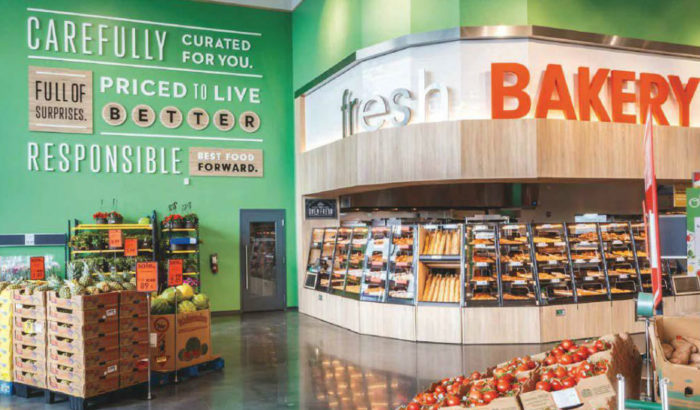
Lidl is tweaking its U.S. expansion strategy – By Beth Mattson-Teig
It has been nearly 18 months since German grocery giant Lidl opened its first U.S. stores and boldly announced plans to have about 100 stores operating along the East Coast by the summer of 2018. Though Lidl fell short of that initial goal, the company is going ahead with expansion, albeit more slowly than planned. After opening three units in September, Lidl’s U.S. store count is at 57 across six states: Delaware, Georgia, Maryland, North Carolina, South Carolina and Virginia.
Lidl has a history of ambitious expansion aims. Having opened its very first store in 1973, the company, known for low prices on its grocery, health-and-beauty and household products, now operates some 10,500 stores across 28 countries.
“Their initial launch was weaker than they expected for a variety of reasons,” said Tina Long, Charlotte, N.C.-based vice president of retail advisory services with Avison Young. Lidl’s initial focus was primarily on acquiring sites for the ground-up development of freestanding stores, notes Long. The company had a “build it and people will come” way of thinking, she says, but now management is recalibrating its approach. (Avison young has provided evaluation services for several sites Lidl looked at in the Carolinas over the past few years.)
Lidl is taking a broader vew now that includes acquisition or leasing of existing spaces, says Long. Moreover, the company is focused on denser communities and on strong co-tenancy setups with other national retailers within established, strong-traffic trade areas. And the store size has been reduced from 36,000 square feet to about 15,000 to 25,000 square feet. “They were very quick to realize hiccups, and they have made changes,” said Long. “They have slowed their growth on purpose, to make corrections, because I really believe they are in this for the long term.”
Lidl had announced plans for expansion in Texas and was seeking sites there in 2016 and 2017. The company had in fact made some moves on a few places, with either signed letters of intent or completed sales, but now any such plans for Texas appear to have been put on ice, according to Jason Baker, a principal at Houston-based real estate brokerage Baker Katz. In talking to Lidl’s people and reflecting on the company’s real estate decisions, namely going after B-quality sites, Baker says his sense was that Lidl thought it could enter the market and gain share quickly, perhaps thanks to its size as a global company. “I don’t know that that’s going to be the case here now, or ever,” he said. Lidl would have been a late entrant into what is already an incredibly competitive Houston grocery market, he notes. The good news is that backing out of Texas should be relatively easy, because the company has not signed any lease commitments, Baker says.
Another read on Lidl’s shift of both geographic and real estate strategy is the emergence of new leadership. In May the company announced that Johannes Fieber had been named president and CEO of the Lidl U.S. division. Fieber has been with the company for about a decade, having been CEO of Lidl’s Sweden division.
Among Lidl’s challenges now is its entry into an already crowded U.S. grocery sector that operates on thin margins as it is. Lidl’s low-price model sets the company into direct competition with the likes of Aldi and Walmart, not to mention the dollar stores that offer discounted grocery items in their own right. When Lidl comes into a market it forces othe rgrocers to drop their own prices, says Long. In the Carolinas, she says, Walmart, Food Lion and Dollar General have cut prices on some items by between 10 and 30 percent to compete against Lidl.
Lidl can well afford to bide its time with expansion plans. Parent company Schwarz Gruppe is one of the 10 largest retail companies in the world. So though the privately held grocer did have to walk back that big number for projected store openings, there were no stock analysts holding them to anything, nor did the chain have to worry about shareholder impatience or about any troubling impact on share prices. “The family can move at the pace they feel is right, and they can play this for the long game,” said Mike Siska, a managing director of consumer and retail with Chicago-based William Blair & Co. “I think they have probably learned and enormous amount over the past 12 to 18 months, and I would not count them out.”
Another positive for Lidl is that it seems to have caught the fond eye of the Millennials. A June survey by consulting firm Oliver Wyman showed that nearly half the 600 respondents who had tried Lidl began to shop there regularly (defined as at least twice per month). Among the younger respondents, the numbers are even higher: 71 percent of those between 18 and 24 said they shop at Lidl regularly, as do 62 percent of those between the ages of 25 and 34.
“If they continue on this path with a new strategic growth plan, and if they can stay nimble and keep changing as they see that they need to in order to suit the customer,” Long said, “then I think they can remain viable in the long run.”
Read the Original Article HERE